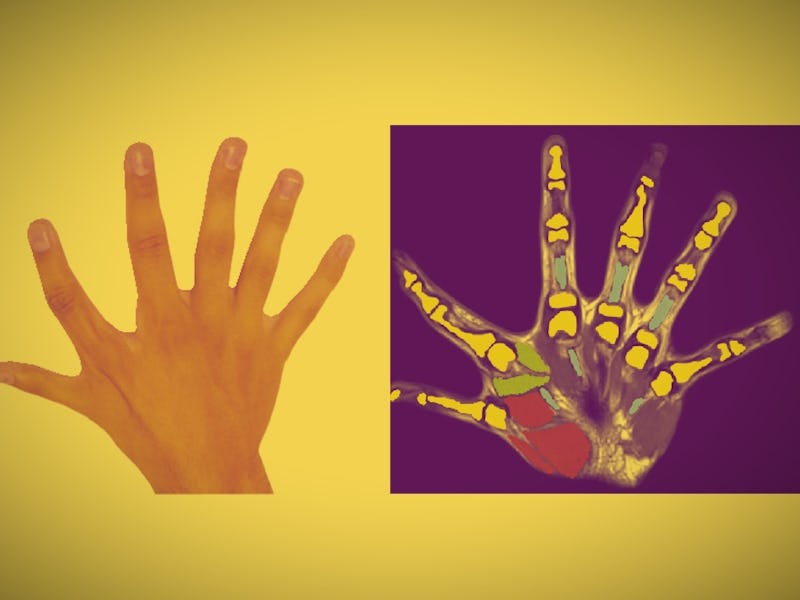6-Fingered Family's Impressive Dexterity Suggests We All Need an Extra Digit
"It may be of value to augment normal five-fingered hands with an artificial supernumerary finger."

While having an extra digit was once revered by ancient canyon dwellers, extra fingers are usually removed today. A recent case study of two unique individuals published in Nature Communications, however, suggests they’re worth keeping, outlining the impressive advantages that extra digits can bring and how the brain can drive this superior dexterity.
"…it may be of value to augment normal five-fingered hands with an artificial supernumerary finger."
The case study, published in early June, describes a 52-year-old mother and her 17-year-old child who were both born with an extra finger between their pointer finger and thumb. It’s been reported that roughly 0.2 percent of people are born with extra digits (in various positions on the hands and feet), but others estimate that one person out of every 700 to 1,000 live births has an extra appendage.
Not all those people can move their extra digits. But those investigated in the case study were capable of some extraordinary dexterity, says study author Carsten Mehring, Ph.D., at the University of Freiburg in Germany. He and his colleagues were so impressed that they wrote: “it may be of value to augment normal five-fingered hands with an artificial supernumerary finger.”
The Six-Fingered Hand
“Our subjects can use their extra fingers independently, similar to an additional thumb, either alone or together with the other five fingers, which makes manipulation extraordinary versatile and skilful,” said Mehring. “For instance, in our experiments subjects can carry out a task with one hand, for which we normally need two hands.”
These extra fingers were controlled by their own networks of muscles and tendons, and, crucially, had their own pathways in the brain. The team is hoping their discovery may inform how we design robotic appendages to fit both our bodies and our brains.
Mehring, working with Etienne Burdet, Ph.D., a professor of human robotics at Imperial College London and a team of others, had each subject perform a series of physical tasks to test the capacity of their extra digits. The team observed that the extra digits were able to operate independently in spherical space, moving similarly to a thumb, affording their subjects an “extra degree of freedom.”
This ability greatly increased the amount of movements their individual hands could do, which included tying shoes with one hand, flipping book pages, folding napkins, and rolling towels.
The Six-Fingered Brain
The authors were curious about the roots of that extra dexterity in the brain. Using brain imaging from one of the participants, (the other had a metal dental implant, so no brain scans there), the team showed how the brain adapted to manage it. That extra finger, it seems, was commanded by its own neural resources in the sensorimotor cortex. In other words, these individuals had developed an additional neural pathway that was dedicated solely to that extra digit:
"In a nutshell, it is amazing that the brain has enough capacity to do it without sacrificing elsewhere."
“The results show that the representation of the supplemental finger in the primary sensorimotor cortices was distinct from the representations of all other fingers, including the thumb,” the team writes. “This demonstrates that separate neural resources are used to control movements of the supplemental finger in this six-fingered subject.”
Brain scans on one of the study subjects showed that the extra digit recruited extra neural resources to help control its movements.
Crucially, the dedication of these additional resources in the brain didn’t come at the expense of other digits. “In a nutshell, it is amazing that the brain has enough capacity to do it without sacrificing elsewhere,” added Burdet. He and Mehring, who have both studied brain computer interfaces and robotics, offer up their findings as a blueprint for the development of additional artificial appendages, at least from a biomechanical standpoint.
One snag they’ll have to get over, however, is the fact that the people in the case study had their extra digits from birth, whereas people who get artificial appendages have never had an extra limb. It isn’t clear how or if their brains will adapt.
“The additional extremities have been trained in the subjects since birth,” the authors write. “This does not necessarily mean that similar functionality can be achieved when artificial limbs are supplemented later in life.”
Those of us who have never known any digits beyond five may find that even with our new flashy robotic appendages, our brains come up short. As advanced as artificial limbs and digits may become, the key to making them useful will be ensuring there are pathways in the brain that allow us to control them as if they were there since birth.
Abstract:
Neurotechnology attempts to develop supernumerary limbs, but can the human brain deal with the complexity to control an extra limb and yield advantages from it? Here, we analyzed the neuromechanics and manipulation abilities of two polydactyly subjects who each possess six fingers on their hands. Anatomical MRI of the supernumerary finger (SF) revealed that it is actuated by extra muscles and nerves, and fMRI identified a distinct cortical representation of the SF. In both subjects, the SF was able to move independently from the other fingers. Polydactyly subjects were able to coordinate the SF with their other fingers for more complex movements than five fingered subjects, and so carry out with only one hand tasks normally requiring two hands. These results demonstrate that a body with significantly more degrees-of-freedom can be controlled by the human nervous system without causing motor deficits or impairments and can instead provide superior manipulation abilities.